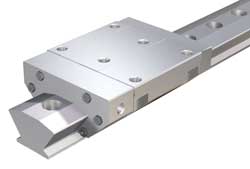
Posted to News on 11th Apr 2008, 15:45
Hydrostatic linear bearings are simple to install
Schaeffler (UK) has developed an innovative range of high-precision hydrostatic linear guides that are not only cost-effective and easy to mount, but also fit the same design space as a rolling element guidance system.

When selecting bearing supports for linear motion applications, most machine builders opt for profiled rail linear guides, which provide a good combination of performance (rigidity, load capacity and dynamics) and ease of installation. However, hydrostatic linear guides are now a cost-effective option, as they offer both high precision and better damping characteristics for high dynamic rigidity. To date, most hydrostatic guides have been relatively expensive, time-consuming to mount and require a larger design envelope compared to profiled rail guides. But engineers from the Schaeffler Group's Linear Division, working closely with the Machine Tool Laboratory at the University of Aachen in Germany, have developed a range of hydrostatic linear guides that are suitable for high-precision machining and machine tool applications, offering design engineers and machine builders much greater design freedom.
The hydrostatic guides are manufactured to fit within the standard design space (DIN 645) of a profiled rail linear guide; moreover, the load carrying capacity has also been found to be equal to the operating load of a profiled rail linear guide of similar size. Compressive rigidity is also comparable to a roller monorail system.
New-builds, variants and upgrades
For machine builders and end users, the ease of mounting means design and assembly costs are reduced. And, because the guides comply with DIN design envelopes and DIN mounting dimensions for monorail guidance systems, a design engineer could, for example, use both a roller guidance system and a hydrostatic guiding element in the same machine design, but for a variety of machine tool performance classes. Alternatively, the hydrostatic bearings could be used to upgrade an existing machine.
Unlike conventional ball linear guides or roller linear guides, the hydrostatic guides eliminate all metal-to-metal contact. The guide carriages move on a thin cushion of high-pressure fluid, the end result being zero wear of the guideways. An integral hydraulic controller means the hydrostatic guides are supplied ready-to-fit.
Impact vibration tests and torsional load (continuous vibration) testing on machine tools, for example, have shown that hydrostatic guideways provide improved dynamic stiffness for heavy cutting capability and chatter resistance, as well as better damping characteristics compared to conventional linear ball guides. The result is longer tool life and improved part surface finish and roundness.
Vibration in machine tools can be a serious problem. Vibrations are induced as a result of blade contact shocks, tool wear, regenerative effects and other disruptive forces from outside influences. Due to the large number of "springs' and "masses', numerous resonant frequencies occur with, in some cases, strong effects on the accuracy and surface quality of the workpieces. In such cases, however, the lubricant film separating the components in hydrodynamic and hydrostatic guidance systems provides vibration damping by means of the so-called "squeeze film' effect. This damps - or even eliminates - amplitude elevations in the resonant frequencies. The dynamic rigidity of the machine is improved and higher precision is achieved.
Infinite life
Bearing life for hydrostatic guides can be considered to be infinite, as there is no bearing wear, resulting in longer machine life and extended rigidity and precision. Crash protection also improves, because the oil pressure in the pocket increases as the cutting load is applied, creating a restoring force that prevents the fluid gap from closing under very high impact loads.
Peter Lutz, head of the Roller Guidance Systems Product Group at Schaeffler Group, summarises the benefits of the hydrostatic guides: "The novel feature of this new concept is that the hydrostatic guidance system conforms to the standard design envelope in accordance with DIN 645 for a monorail guidance system. The prototypes have a load carrying capacity approaching the operating load range of a monorail guidance system of the same size. The pocket geometry and hydraulic control system have been adapted in such a way that the static rigidity in the compressive direction is equivalent to that of a monorail guidance system."
For the hydrostatic linear guide prototypes, pocket pressure is 100 bar, load carrying capacity is up to 18kN and through-flow rate is less than 3 litres/min. Gap height is 0.015mm.
Schaeffler is currently working with its customers to develop designs for volume production.
For more information visit www.schaeffler.co.uk.
Want the latest machine building news straight to your inbox? Become a MachineBuilding member for free today >>

















